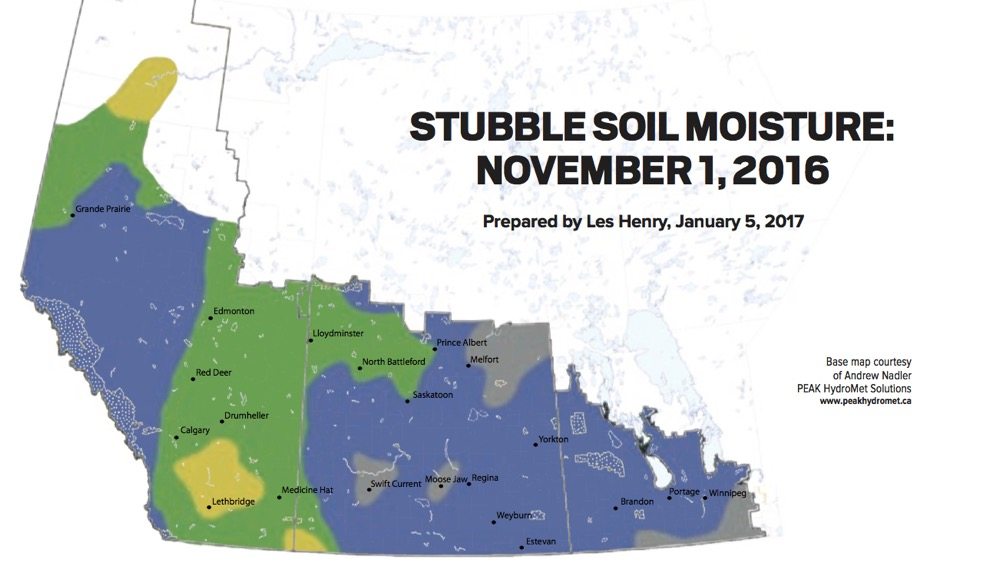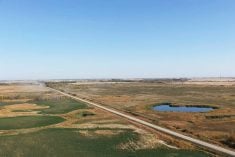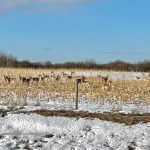The November 1, 2016, fall soil moisture map was, in a word, wet. In Manitoba and much of Saskatchewan all soils were at field capacity (holding maximum available water) and many areas were so wet that water tables were near enough to surface to be a factor.
When the water table is within about five to six feet of the soil surface, Mother Nature’s sub-irrigation kicks in. The soil can suck water up from the water table — about two feet, depending on soil texture.
As 2017 unfolded and the rains did not come many “hangers on” were screaming about drought and predicting a disaster. Grainews readers knew different. You knew that a soil full of water is like money in the bank and the crop would do well if it did not get too hot.
And so it unfolded: a very good crop and the real upside was little disease. Some folks in southern Saskatchewan suffered from loss of surface moisture for germination so did have a poor crop.
- More with Les Henry: Exhibit 1: Weather cycles — Willowbunch Lake
Southern Alberta included dry areas on the 2016 map (see below) and less than adequate rain cut yields substantially in that area. As we look back to soil moisture maps of previous years it becomes evident why there is so much irrigation in southern Alberta. They really need it most years.
In central Saskatchewan many irrigation pivots have sat idle for much of the past several years. Even in dry 2017 I did not see huge yield reductions on the dryland corners of pivots I drive by on a regular basis.
The November 2017 map and the 2018 crop
The low rainfall for many areas in 2017 resulted in the crop sucking available water out of the soil. Southwest and south central Saskatchewan and parts of southern Alberta are very dry and have no subsoil moisture reserve. The 2018 crop will rely on snow melt and rain. Snow melt can often provide what is needed for germination but any delay in rain means a rapid cut in crop yield. That is especially true for cereals that set the yield potential early. Canola can kick back in with late rain and shoot out new branches to maintain yield potential.
Read Also

Claas brings 1000 Series SP forage harvesters to Canada
In mid-August, Claas unveiled its new line of Jaguar forage harvesters at an event in Visalia, California, deep in the heart of that state’s dairy region.
The large dry area in Saskatchewan and Alberta has small reserves and timely rain will be needed there also. There is no way of predicting rain so planning for fertilizer etc. can be based only on “probability of precipitation.” For those who have Henry’s Handbook of Soil and Water, check out pages 115 to 118 to see how it works.
Manitoba
Manitoba was a special case this year. Much of Manitoba received below average rain but the good reserves of 2016 carried the day. It was very difficult to set the dry/moist boundary. Many locations were borderline between the two categories. Mapping dry soils in Manitoba is almost sacrilege so I do it with some trepidation!
Much of Manitoba had almost no rain in October. The daily rain record of the 100+ Manitoba Government weather stations was one of the data sources consulted to make the map.
The future
Moisture is a very important factor in determining how hard the trucker works in the fall. With all the hype about precision ag, fancy technology and big data, it is surprising that so few agronomists provide farmer clients with an inventory of soil moisture reserves. Perhaps some readers will enlighten me with examples to refute that statement.
I am still waiting for the next generation to come out with a better map than this so I can retire my five coloured pencils. So far, no takers. In my next column I will expand on the soil moisture question, sources of data and procedures to customize data for specific areas and farms.

















